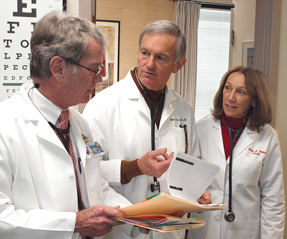Influencing the details of health reform so internists get paid
It is often said that people don't see the forest for the trees, obsessing on the details instead of the big picture.
It is often said that people don't see the forest for the trees, obsessing on the details instead of the big picture. Sometimes, though, it is important to see the trees for the forest.
If the forest is the Affordable Care Act (ACA), the trees are the programs created by it. Some may want to expand the forest, others to prune it, others to cut it down and grow something else. But even as we debate the forest's future, it is important to pay attention to the trees, those individual programs that impact internists and their patients.
One such tree is the Medicare Primary Care Incentive Program (PCIP). This program will give eligible primary care physicians a 10% bonus on top of their regular Medicare payments for office visits and other designated services, starting on Jan. 1. The American College of Physicians (ACP) played a key role in getting the bonus into the law, even as it urged the Congress to take even bigger steps to improve primary care reimbursement.
Getting the program included in the law was only the beginning. ACP understood that the law was written in a way that gave the Centers for Medicare and Medicaid Services (CMS) considerable discretion in how it would be implemented. CMS could be as permissive as possible to allow as many office-based general internists to qualify, or it could be more restrictive and exclude many internists based on an arbitrary and unfair definition of what constitutes primary care.
CMS issued a final rule that will allow the vast majority of office-based primary care internists to qualify for the bonus that went into effect Jan. 1. But this only happened because ACP persuaded CMS to change its original proposal, which would have unfairly excluded most general internists from qualifying.
The ACA provides a 10% bonus payment on top of the fee schedule payment for “designated primary care services” furnished by primary care physicians in calendar years 2011-2015. To qualify, physicians must be self-designated in a primary care specialty of general internal medicine, family medicine, pediatrics or geriatrics. The law requires that 60% of a physician's Medicare billings (allowable charges) must be for the same designated primary care services to which the 10% bonus would apply. Office, nursing home, home and custodial care services are designated primary care services, but hospital visits are not.
In the spring of 2010, CMS proposed to look back on the percentage of designated primary care services furnished by the physician during an earlier time period, to ensure that they constituted 60% of the physician's total Medicare charges. This would have excluded most office-based general internists. Charges for in-office laboratory work and hospital visits would count against the calculation of whether a physician qualified for the bonus. The more ancillary procedures and hospital visits a physician bills to Medicare, the less likely that 60% of total Medicare billings would be only for office, nursing home, home, and custodial care services, the designated primary care services as defined by the law.
This would have had the effect of disqualifying most general internists. Sixty-five percent of general internists work in an office in which lab testing is performed, and 77% of ACP members in active general internal medicine practice provide at least some inpatient care.
ACP submitted comments to CMS that urged changes in the rule so that internists would not be disqualified because they provide point-of-care laboratory testing and see their patients in the hospital. The College noted that “following a patient in the hospital setting provides continuity of care and is a hallmark of traditional primary care practice.”
The College also pointed out that laboratory tests are integral to management of many chronic conditions, which primary care physicians commonly treat. An ACP analysis of data from the 2007 National Ambulatory Medical Care Survey shows that general internists report that their office visits often involve a patient with one or more chronic conditions, with 43% of visits furnished to patients with hypertension, 28% to those with hyperlipidemia, and 19% to those with diabetes.
ACP raised its objections at the highest level of CMS, and organized a joint advocacy effort with the American Academy of Family Physicians, American Osteopathic Association, and National Rural Health Association.
In its final rule, CMS accepted ACP's argument, and decided that in-office laboratory tests and hospital visits will not count against a physician in determining eligibility for the primary care bonus. Accordingly, a vast majority of office-based general internists should now qualify. ACP estimates that an internist who has a typical mix of Medicare patients and billings should see an overall gain in Medicare revenue of $10,000 or more, for each of the next five years, although the exact impact will depend on each physician's mix of patients and services. Because of ACP's advocacy, many thousands more internists will get the bonus.
Internists may disagree on the overall health reform law, but influencing the regulations on key provisions is an essential part of ACP's advocacy. The remarkable PCIP success story shows why ACP can't just pay attention to the forest, but also must nurture and protect the trees of health reform to the benefit of internists and their patients.





